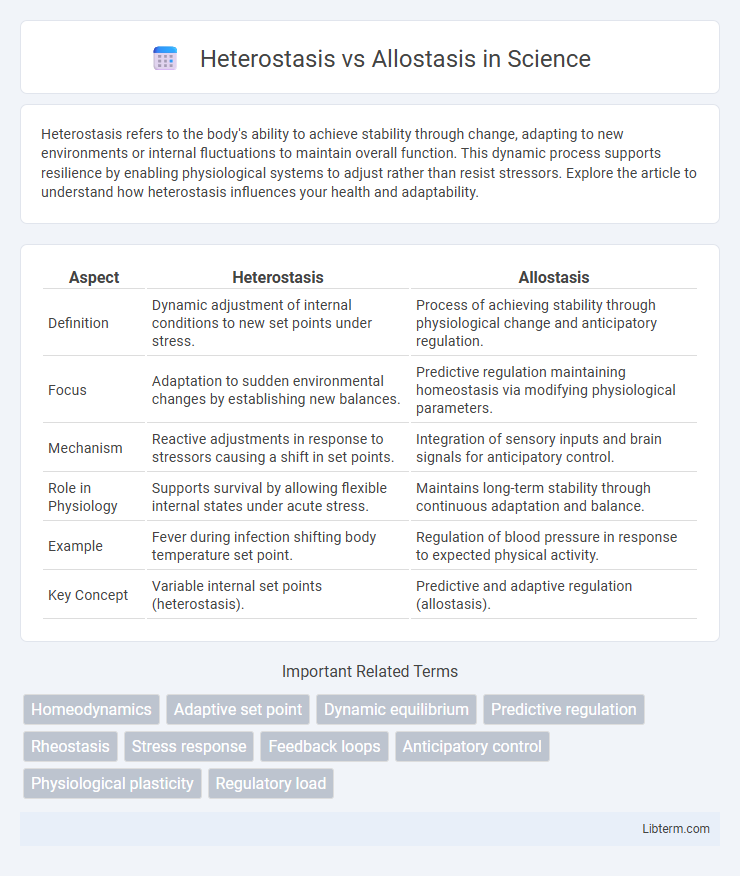Heterostasis refers to the body's ability to achieve stability through change, adapting to new environments or internal fluctuations to maintain overall function. This dynamic process supports resilience by enabling physiological systems to adjust rather than resist stressors. Explore the article to understand how heterostasis influences your health and adaptability.
Table of Comparison
| Aspect | Heterostasis | Allostasis |
|---|---|---|
| Definition | Dynamic adjustment of internal conditions to new set points under stress. | Process of achieving stability through physiological change and anticipatory regulation. |
| Focus | Adaptation to sudden environmental changes by establishing new balances. | Predictive regulation maintaining homeostasis via modifying physiological parameters. |
| Mechanism | Reactive adjustments in response to stressors causing a shift in set points. | Integration of sensory inputs and brain signals for anticipatory control. |
| Role in Physiology | Supports survival by allowing flexible internal states under acute stress. | Maintains long-term stability through continuous adaptation and balance. |
| Example | Fever during infection shifting body temperature set point. | Regulation of blood pressure in response to expected physical activity. |
| Key Concept | Variable internal set points (heterostasis). | Predictive and adaptive regulation (allostasis). |
Introduction to Heterostasis and Allostasis
Heterostasis refers to the dynamic adjustment of internal conditions in response to external environmental changes to maintain stability with flexibility. Allostasis involves the predictive regulation of physiological systems through adaptive mechanisms to achieve homeostasis in anticipation of future demands. Both concepts emphasize the body's capacity to regulate and balance internal states beyond static homeostatic processes.
Defining Heterostasis
Heterostasis refers to an organism's ability to maintain internal stability through adaptive changes in multiple physiological variables beyond a fixed set point, allowing dynamic responses to fluctuating environments. Unlike allostasis, which emphasizes predictive regulation and anticipatory adjustments to stressors, heterostasis highlights flexible, non-linear adjustments without a predetermined baseline. This concept is crucial for understanding complex homeodynamic mechanisms in systems biology and physiology.
Understanding Allostasis
Allostasis refers to the process by which the body achieves stability through physiological or behavioral change, optimizing adaptation to stress and environmental demands beyond simple homeostatic regulation. It involves complex interactions among the nervous, endocrine, and immune systems to predictively regulate internal balance, enabling dynamic adjustment rather than fixed equilibrium. Understanding allostasis highlights the importance of anticipatory mechanisms in maintaining health and how chronic activation can contribute to disease processes.
Key Differences Between Heterostasis and Allostasis
Heterostasis refers to the process by which an organism stabilizes internal conditions by allowing temporary deviations from baseline homeostasis in response to stress or environmental changes. Allostasis, on the other hand, is the adaptive process of achieving stability through physiological or behavioral changes that anticipate future demands, often involving predictive regulation by the brain. Key differences include heterostasis focusing on reactive adjustments to maintain function, whereas allostasis involves proactive regulation that integrates multiple systems to maintain overall stability during dynamic environments.
Historical Development of Both Concepts
Heterostasis, first described in the early 20th century, emphasizes the organism's ability to maintain stability through change by achieving new steady states in response to stress. Allostasis, introduced by Sterling and Eyer in the 1980s, expanded this concept by highlighting the predictive regulation of physiological parameters to maintain homeostasis proactively. The development of allostasis represented a paradigm shift, integrating neuroendocrine and behavioral adaptations as essential for understanding stress responses and chronic disease mechanisms.
Biological Mechanisms Underlying Heterostasis
Heterostasis involves the dynamic adjustment of physiological processes to maintain stability through variable set points, distinguishing it from allostasis which emphasizes predictive regulation and adaptation. The biological mechanisms underlying heterostasis include flexible enzymatic pathways, cellular signaling networks, and feedback loops that allow organisms to rapidly alter internal states in response to fluctuating environmental conditions. Key components such as ion channel modulation, hormonal shifts, and gene expression changes enable efficient recalibration of homeostatic parameters essential for survival under stress or changing demands.
Mechanisms and Role of Allostasis in Adaptation
Heterostasis refers to the dynamic process by which an organism maintains internal stability through multiple alternative set points, whereas allostasis involves the predictive regulation of physiological systems to achieve stability through change. Allostasis mechanisms include the activation of neuroendocrine, autonomic, and immune responses that anticipate and adapt to environmental challenges, ensuring optimal energy allocation and homeostatic balance. This adaptive regulation enhances resilience to stress and promotes long-term health by modulating cardiovascular, metabolic, and neural pathways in response to fluctuating demands.
Real-World Examples: Heterostasis vs Allostasis
Heterostasis refers to the body's ability to achieve stability through change by switching between different regulatory mechanisms, such as the immune system activating different responses to various pathogens. Allostasis involves the process of achieving stability through physiological or behavioral change, exemplified by increased heart rate and cortisol levels during stress to adapt to external demands. For instance, heterostasis can be seen in insulin regulation where the body shifts between different metabolic states, while allostasis is evident in how the body adjusts blood pressure in response to environmental stressors.
Clinical and Health Implications
Heterostasis involves dynamic physiological adjustments to maintain internal balance under varying conditions, while allostasis refers to achieving stability through change by anticipating and adapting to stressors. Clinically, allostatic load represents the wear and tear on the body from chronic stress, contributing to conditions such as hypertension, diabetes, and cardiovascular disease. Understanding the distinctions between heterostasis and allostasis is essential for developing targeted interventions that mitigate stress-related health risks and improve patient outcomes.
Future Perspectives and Research Directions
Future perspectives in heterostasis and allostasis research emphasize understanding dynamic, non-linear physiological adaptations beyond traditional homeostatic models. Emerging studies prioritize integrating multi-omic data and machine learning to unravel complex regulatory networks driving stress responses and disease resilience. Advancements in wearable biosensors and personalized medicine are expected to enable real-time monitoring and tailored interventions targeting allostatic load and heterostatic balance.
Heterostasis Infographic

 libterm.com
libterm.com